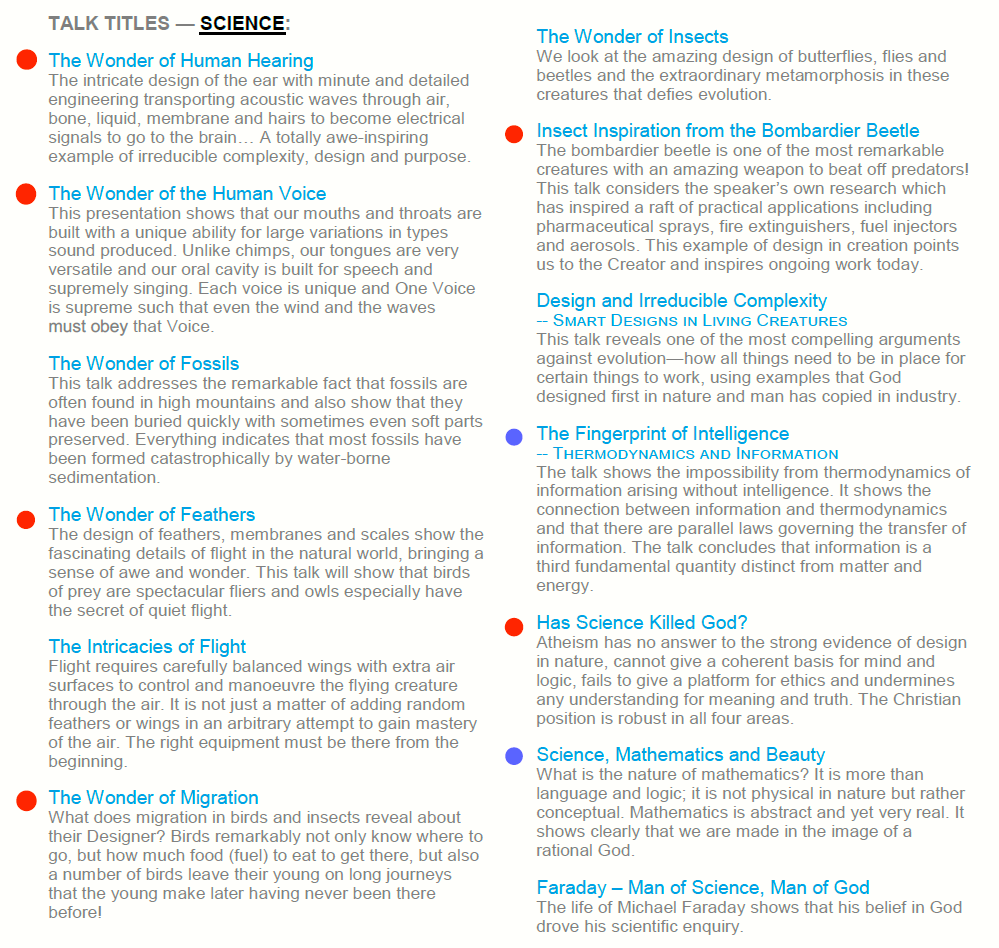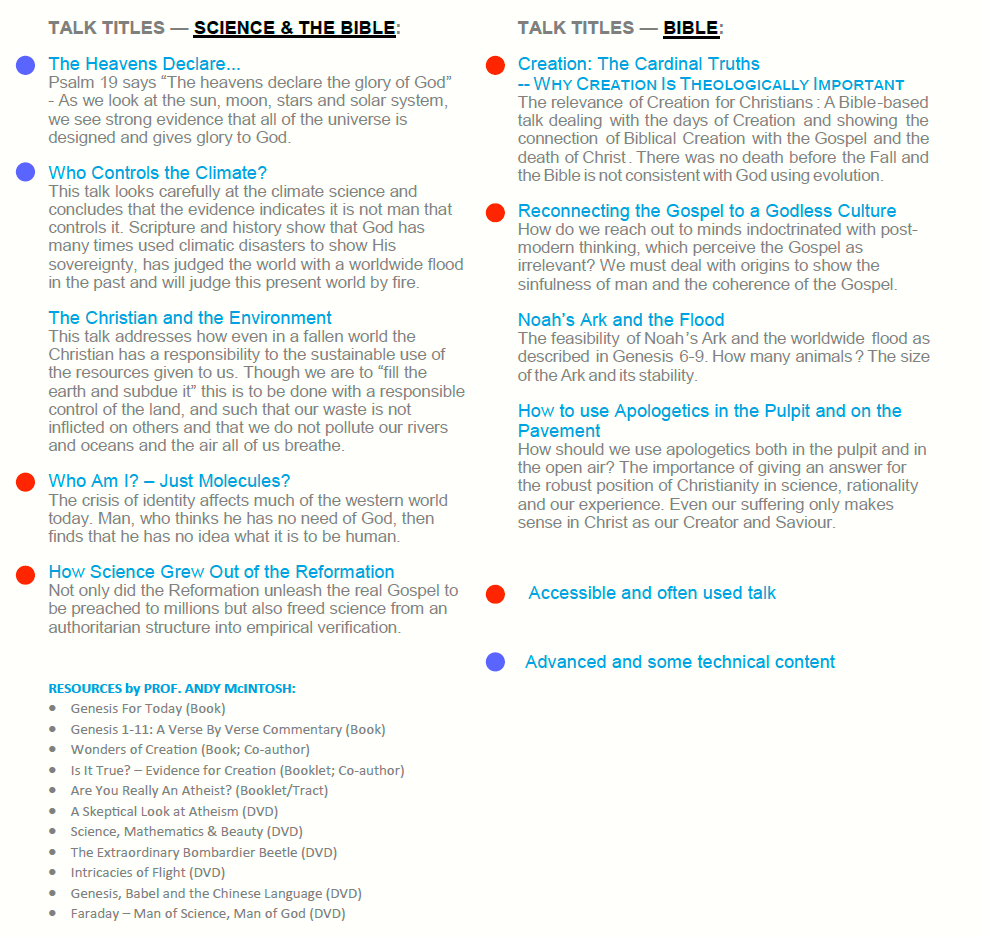February 1, GHCA meeting and webinar
February 1, 7 pm, Grace Bible Church,
13700 Schroeder Road, Houston, TX 77070
Directions: From the intersection of Sam Houston Tollway N. (8) and Tomball Parkway (249), go northwest on 249, after 2.5 miles watch for exit for Schroeder Rd and exit. At Schroeder turn right and follow Schroeder Rd. north about 0.7 miles. Watch for Grace Bible Church sign and turn right into parking lot.
The Fingerprint of Intelligence
– Thermodynamics and Information
By Professor Andy McIntosh
The talk shows the impossibility from thermodynamics of information arising without intelligence. It shows the connection between information and thermodynamics and that there are parallel laws governing the transfer of information. The talk concludes that information is a third fundamental quantity distinct from matter and energy. See list of talks below.
Venue Change for Feb First only:
Grace Bible Church of Houston,
13700 Schroeder Road, Houston, Texas 77070
Directions: From the intersection of Sam Houston Tollway N. (8) and Tomball Parkway (249), go northwest on 249, after 2.5 miles watch for exit for Schroeder Rd and exit. At Schroeder turn right and follow Schroeder Rd. north about 0.7 miles. Watch for Grace Bible Church sign and turn right into parking lot.
GHCA Usually meets in person in the Reception Room of Houston’s First, The Loop, at 7401 Katy Frwy, Houston TX 77024. See the map in the right sidebar. OR, join online by the registration link in our newsletter. Subscribe in the right sidebar. →
Professor Andy McIntosh is making a speaking tour of Texas.
Dr. McIntosh is a professor Emeritus of Thermodynamics at Leeds University, UK and Adjunct Prof. at Liberty U. in the USA. Dr. McIntosh travels the world speaking primarily on creation science issues. The costs are low while on tour and will be prepared to provide any of the presentations listed below in any available open time. Dr. McIntosh is both authoritative and highly engaging.
There are available time slots in Houston starting Wed Jan 31 through Sat Feb 3. We will work with you to fill your needs. Scroll down to see Dr. McIntosh’s prepared presentations.
For information or booking in Houston, contact Frank Mayo at creationnews@comcast.net or call 832-540-7162.
Click images to enlarge.
January 4, GHCA meeting and webinar
January 4, 7 pm,
Archaeological Evidence for the
United Monarchy of Israel
By Dr. Douglas Petrovich,
PhD Syro-Palestinian Archaeology, Professor, epigraphy, and more.
On Jan 4 Dr. Petrovich will continue his series of lectures on the evidences of Hebrews in Egypt and the conquest of Canaan.
Dr. Petrovich tells us the most concentrated attacks on the historicity of the Bible is focused on the reality or nonreality of the united monarchy of Israel, under Saul, Eshbaal, David, and Solomon. However, excavations of the last 15 years or so in Jerusalem and at several other sites have confirmed the existence of an organized polity with the type of infrastructure and manpower that is expected of the early Israelite monarchy. The archaeological evidence will be examined in order to demonstrate the existence of the early Israelite kingdom that David and Solomon built into a major force in the ancient world.
So far D. Petrovich has presented an abundance of crosslinking evidence of the Hebrews in Egypt and the Exodus. He is one a group that is strongly effectively challenging the paradigm form the last century that there is little evidence for all of this so these parts of the Bible must be largely mythological. For more on how that paradigm came about see the article below, Introduction to the State of Biblical Archaeology.
Plan on attending in person or online. Don’t miss Dr. Petrovich’s extensive body of evidence set forth with passion and expertise.
For location see the sidebar to the right. See Registration link below.
Join us on Jan 4, in person in the Reception Room of Houston’s First Baptist, The Loop, at 7401 Katy Frwy, Houston TX 77024. See the map in the right sidebar. OR, join online: Webinar Registration Link. (Register early and receive the Webinar link by email.)
Subscribe to our Newsletter and get a Link to use at 7 pm on meeting day. Newsletter archive available here. Newsletters are mailed about two weeks before events. See newsletter signup in the right sidebar →
Upcoming in February:
Professor Andy McIntosh is making a speaking tour of Texas.
Dr. McIntosh is a professor Emeritus of Thermodynamics at Leeds University, UK and Adjunct Prof. at Liberty U. in the USA. Dr. McIntosh travels the world speaking primarily on creation science issues. The costs are low while on tour and will be prepared to provide any of the presentations listed below in any available open time. Dr. McIntosh is both authoritative and highly engaging.
There are many available time slots in Houston starting Wednesday evening Jan 31,
| Houston | Morning | lunch | afternoon | evening |
| Wednesday Jan 31 | open | open | open | open |
| Thursday Feb 1 | open | open | open | GHCA |
| Friday Feb 2 | open | open | open | open |
| Saturday Feb 3 | open | open | travel | travel |
Scroll down for Dr. McIntosh’s prepared presentations.
For information or booking in Houston, contact Frank Mayo at creationnews@comcast.netor call 832-540-7162.
- « Previous Page
- 1
- …
- 6
- 7
- 8
- 9
- 10
- …
- 25
- Next Page »


